Liquidity Flywheel Drives Binance to 300 Million Users

CRV, Aave, and the Art of Liquidation

Welcome to Deep Dive!
Curve Finance’s CEO Michael Egorov briefly found himself in the spotlight last week as Crypto Twitter spotted him depositing more CRV to Aave V2 in 3 large transactions worth a total of $35mn USD (represented by the orange plus signs below).
-
Egorov currently has $200mn CRV tokens backing a $60mn USDT loan
-
CRV liquidity has suffered in recent months
-
This position was previously targeted by Avi Eisenberg
-
Aave governance is considering how to respond
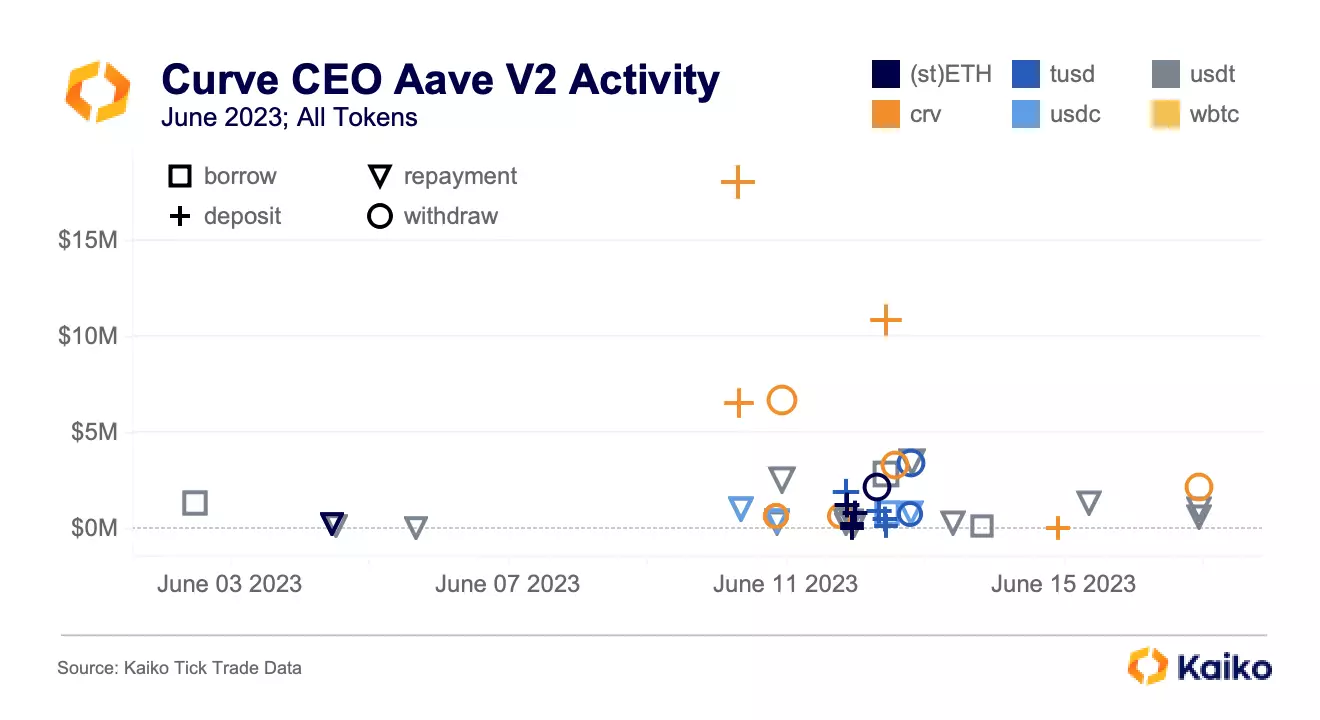
Currently, his position stands at nearly $200mn CRV deposited and $60mn USDT borrowed, making it one of the largest loans in DeFi history. So, why is this significant? And what are the implications for Aave and CRV?
The position
When the CRV token first launched, 30% of supply was allocated to shareholders, meaning the early team and investors. As the CEO and Founder of Curve Finance, Egorov was allocated over 200mn tokens vesting over four years; he has over 50mn still vesting, with 137k unlocked every day.
So, what does someone do when they receive the bulk of their compensation in hundreds of millions of dollars worth of a token that can’t be spent like cash? The obvious answer would be to sell some. However, for a position this large for a token like CRV it would be extremely difficult to liquidate large portions of it without significant price impacts. This action would also be publicly visible, as all on-chain transactions are, showing either selling on a DEX or sending tokens to a centralized exchange. And, if that wasn’t enough, there are tax implications.
Instead, Egorov has opted to utilize DeFi lending and borrowing protocols, depositing CRV tokens as collateral and borrowing stablecoins. Here are his largest positions:
- 285mn CRV tokens deposited on Aave V2 (borrowing $60mn USDT)
- 80mn deposited on Abracadabra (borrowing $20mn MIM)
- 45mn deposited on Fraxlend (borrowing $13mn FRAX)
- 23mn deposited on Inverse (borrowing $7mn DOLA)
We’ll focus on the Aave V2 position because it is by far the largest. For an explainer of the main functions of lending and borrowing protocols check out my Deep Dive from last year, which not-so-coincidentally covers this same position (more on that later).
The chart below shows all of Egorov’s transactions involving major tokens on Aave V2 since the beginning of last year. What’s immediately notable is that last week’s deposits are nowhere near the largest he has ever done.
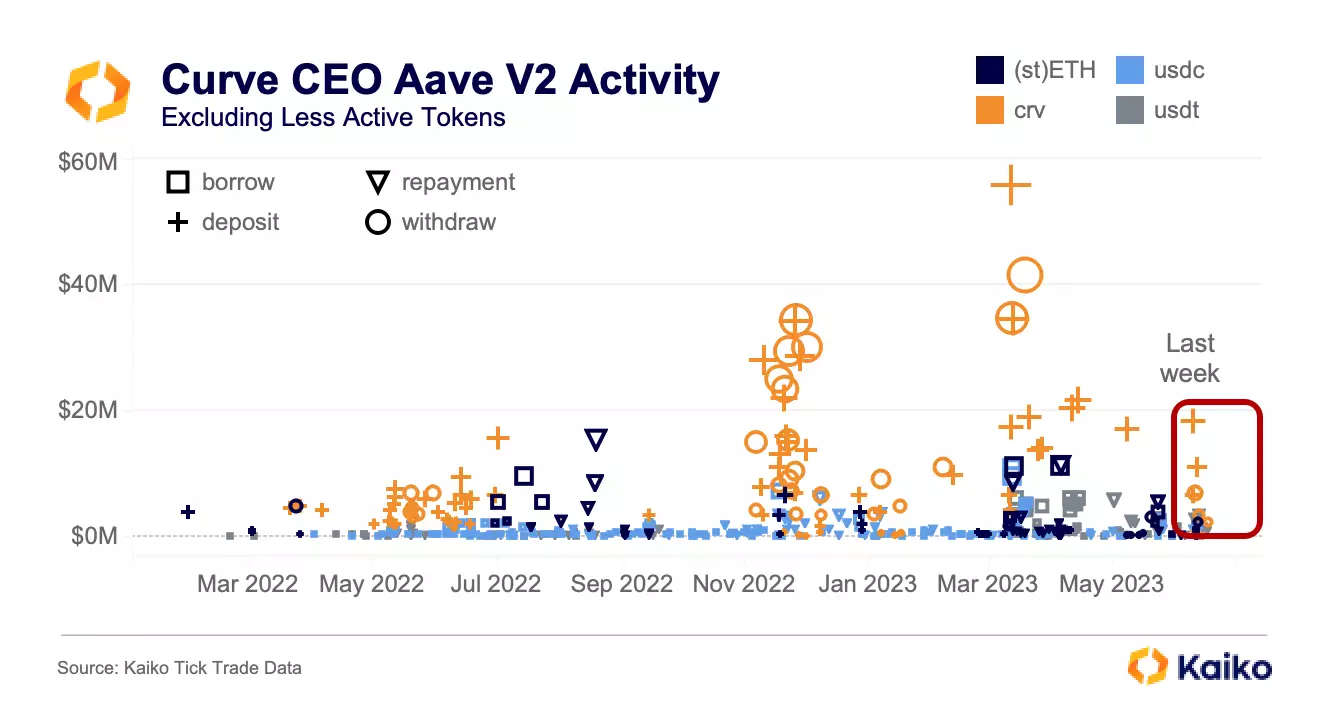
For example, during USDC’s depeg in March, he deposited $55mn of CRV tokens in a single transaction, likely to protect the position’s health and prevent liquidation in the event CRV’s price dropped quickly. In the following month, he deposited a further $140mn CRV in just 7 transactions.
However, the period of greatest activity came during November 2022. The chart below shows his activity aggregated by month below to get a better sense of scale.
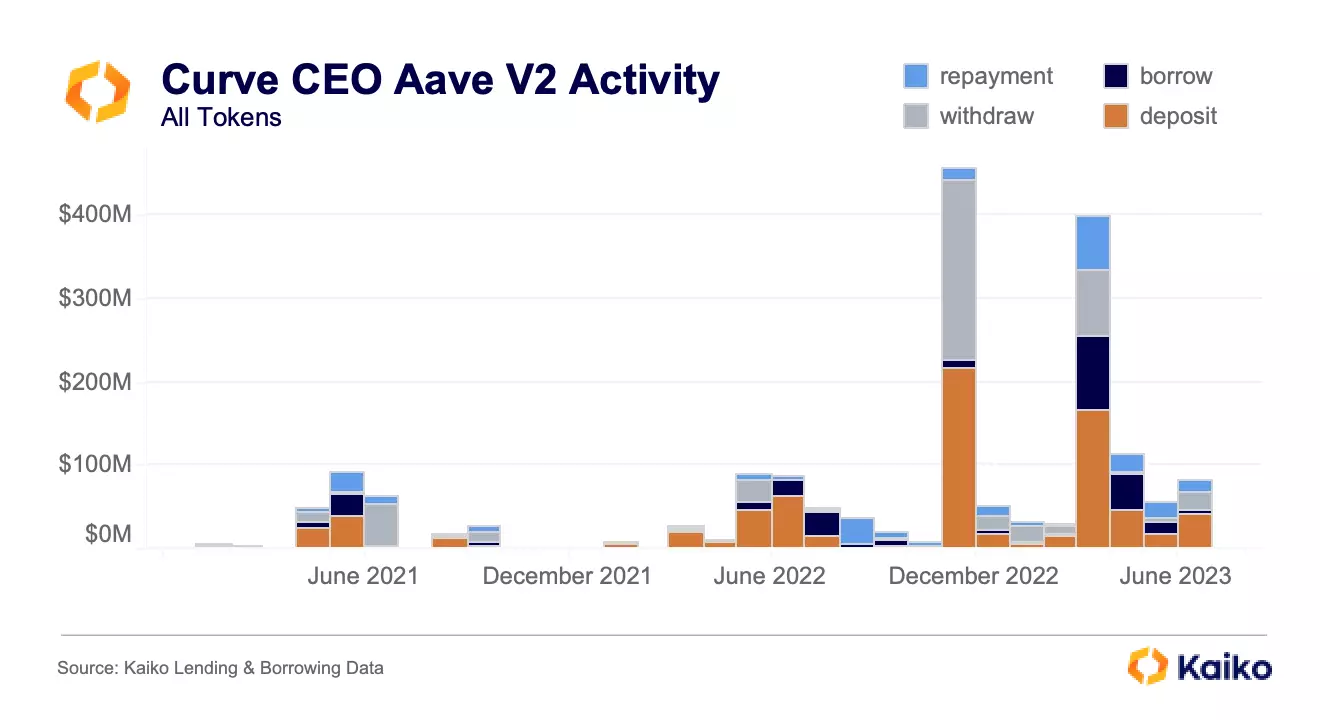
November 2022 immediately stands out with $215mn worth of deposits, $216mn of withdrawals, just $10mn of borrows, and $15mn of repayments. This was a month with two major market events: the collapse of FTX, which sent CRV’s price down 50% in a matter of days, and Avi Eisenberg’s attempt to exploit Aave.
The latter saga was covered in-depth in the Deep Dive I linked to above and involved Eisenberg targeting Egorov’s CRV collateral (which was just $45mn at the time) by borrowing CRV, sending it to OKX and presumably selling it in an attempt to reduce the collateral’s value and drop the loan’s health to the point that it could be liquidated.
What became clear, though, is that Egorov is attentive to his position’s health and has significant resources to protect it. In the wake of the Eisenerg exploit attempt, Aave governance voted nearly unanimously to pause borrowing of CRV while still allowing it to be used as collateral. Since then, Egorov’s CRV collateral position has grown by more than $100mn.
Shown as a percentage of Aave’s total deposits, we can see that CRV grew from 2% of deposits in November to a high of nearly 5% last month, more than DAI and about double 25 other altcoins combined (represented by “Others” below).
Additionally, Egorov’s wallet is responsible for nearly 95% of the CRV deposited on Aave V2, making this market extremely concentrated and more significant to Aave than ever, with some important implications going forward.
Never miss an analysis.
Subscribe to our free weekly Data Debrief email, or learn more about our premium research subscriptions here.
The art of liquidation
Liquidations on DeFi lending and borrowing protocols follow some basic principles: a liquidator sees that a position has entered the liquidation threshold, then the liquidator repays some amount of the borrowed token in exchange for a corresponding amount of the collateral at a discount, generally in the range of 4% to 10%. In the case of Avi Eisenberg’s attempted exploit, the collateral was USDC and CRV was borrowed, meaning liquidators repaid CRV to receive USDC at a discount.
However, like most things on-chain, liquidation is more complicated than it may seem. Continuing with the Eisenberg example, because the position was so large – about $40mn CRV borrowed – it was difficult for liquidators to source CRV tokens to repay the loan in an efficient manner.
As charted below, the liquidation of this position took about an hour and over 300 transactions, with 20 different liquidators joining in.
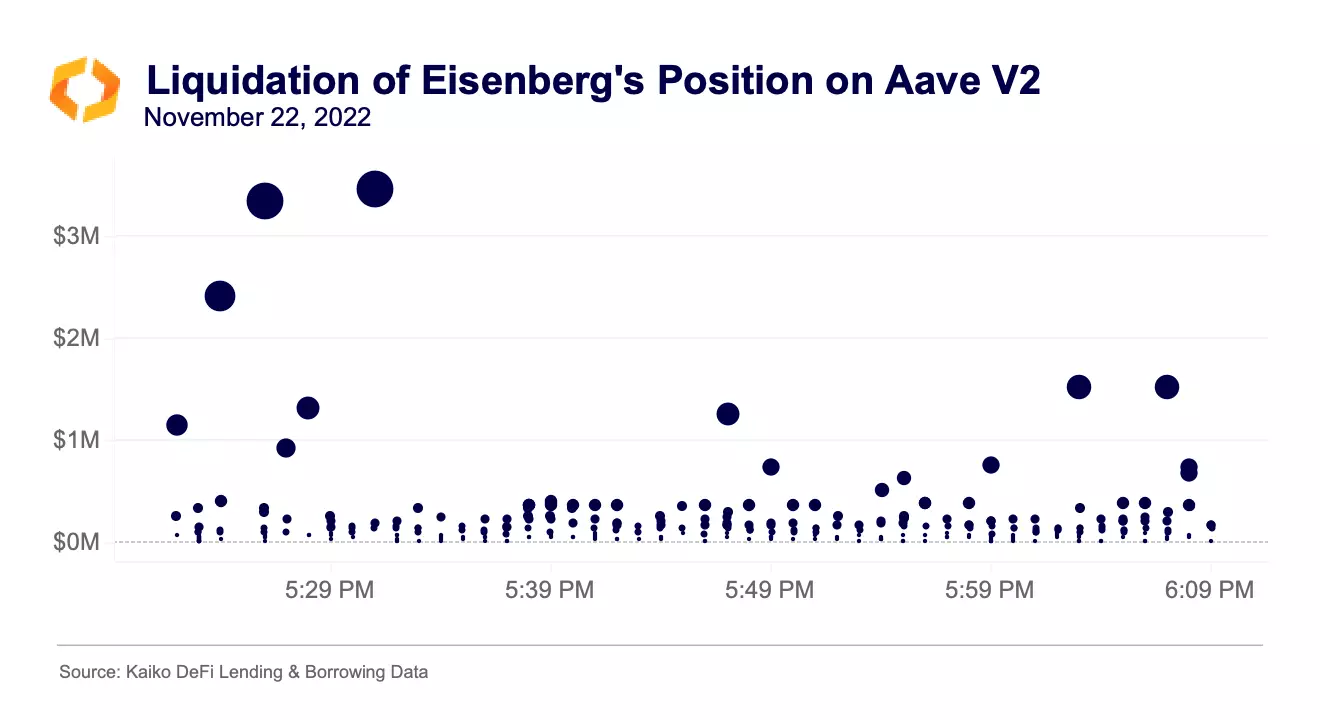
The price of CRV rose while the position was being liquidated, which created a mismatch between the (discounted) collateral and loan value, eventually saddling Aave with 2.6mn CRV tokens of bad debt.
This is the opposite of how a hypothetical liquidation of Egorov’s position might go. In that instance, liquidators would repay the USDT loan and receive discounted CRV tokens. However, this position is significantly larger – the Aave V2 collateral represents about 30% of CRV’s circulating supply. When including other lending and borrowing protocols, this figure approaches 50%.
Again, liquidity comes into play, this time on the back end of the transaction. Liquidators will only repay a loan if it’s profitable for them to do so and are unlikely to hold onto CRV tokens, instead opting to sell them for a stablecoin or ETH. For example, in many of the liquidations shown above, liquidators were borrowing ETH from dYdX, swapping ETH for CRV, repaying CRV, receiving USDC, swapping for ETH, and keeping any extra ETH as profit – all in a single transaction.
In the case of Egorov’s position, liquidators would do something like: swap ETH for USDT, repay USDT, receive CRV, swap CRV for ETH. It’s only guaranteed to be profitable if they are able to immediately sell the CRV tokens they receive with decent execution. Additionally, selling pressure from the early liquidations would further drop CRV’s price, possibly to the point where the collateral is worth less than the borrowed tokens.
The single largest source of liquidity for CRV is on Curve itself in the CRV-ETH pool, which currently stands at about $50mn TVL. Uniswap V3, meanwhile, stands at just over $4.5mn across all of its CRV pools.
To make matters worse, centralized exchange liquidity is also thin, with just over $1mn worth of bids within 2% of the mid price, aggregated across all of the exchanges that we cover.
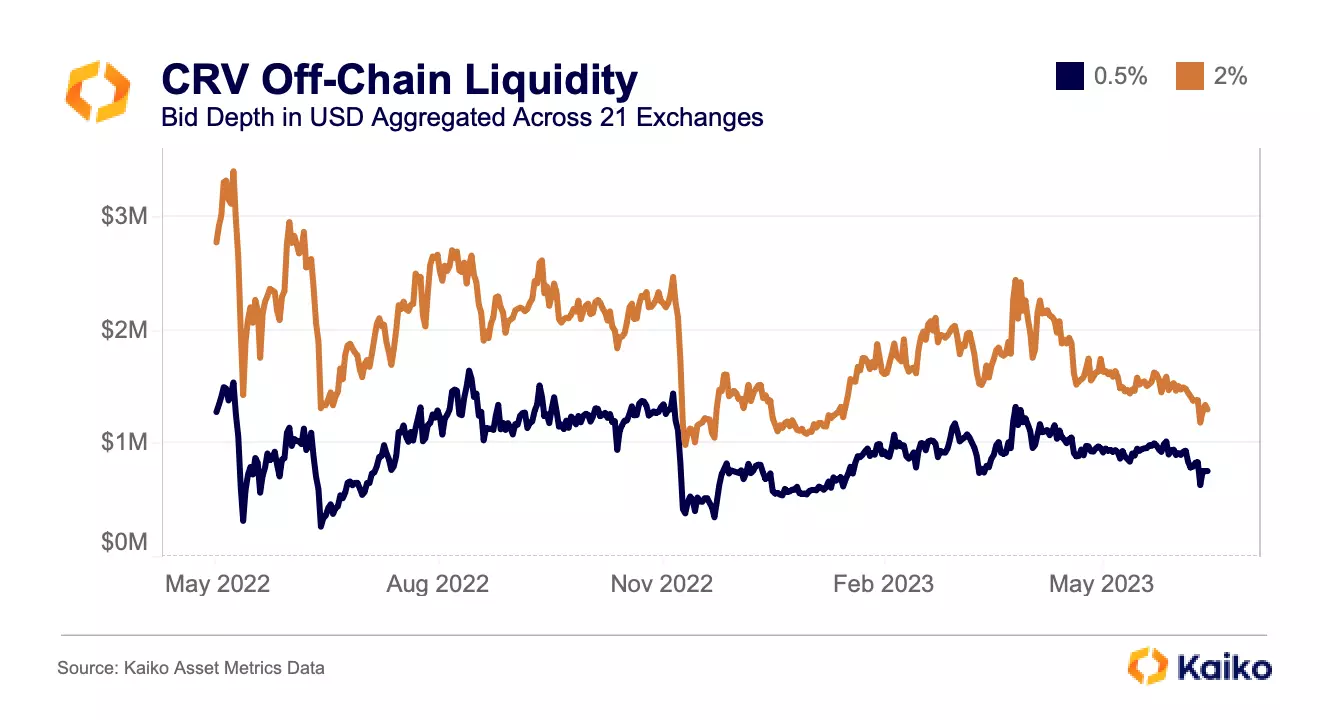
It’s safe to say that there is nowhere near enough liquidity to make liquidating the entire position profitable, which raises the specter of bad debt.
Bad debt
Eisenberg’s failed exploit of Aave that nonetheless left it with 2.6mn CRV tokens of bad debt, a small enough figure that governance opted to purchase using funds generated from its Collector Contract. However, if Egorov’s position were to be liquidated, it’s highly likely it would result in a much larger amount of bad debt. A hole of this size would likely require Aave to utilize its much-maligned (by me) Safety Module, which sells AAVE tokens to cover bad debt. I’ve already written a few times expressing my belief that the Safety Module is poorly designed and a significant risk to the AAVE token. Fortunately, governance discussions regarding diversifying the Safety Module are ongoing.
Conclusion
Like many things in crypto, there was a healthy dose of speculation last week when Twitter found out about this position. What if Egorov never intends to repay? What if he’s fine getting liquidated? If anything, the data suggests the reverse: he has diligently maintained the health of his loan even as its size has grown beyond what Aave governance is comfortable with.
With that said, it is concerning to see such a large portion of CRV’s circulating supply used as collateral, as crypto is certainly no stranger to flash crashes. Ultimately, this saga proves the importance – especially for lending and borrowing protocols – of monitoring the data and responding quickly as risks change.
Data Used In This Analysis

More From Kaiko Research
![]()
Derivatives
22/12/2025 Data Debrief
Crypto in 2026, What Breaks, What Scales, What ConsolidatesCrypto markets enter 2026 in a markedly different position than in prior cycle transitions. Rather than resetting after a speculative peak, the market appears to be progressing through a phase of institutional consolidation.
Written by Thomas Probst![]()
Year in Review
01/12/2025 Data Debrief
Kaiko Research's Top 10 Charts of 2025In this report, we look back on 2025 and the key forces that shaped markets. From BTC record highs and fleeting altcoin rallies to major liquidation events and evolving regulation, we examine what shaped a seminal year for crypto.Written by Adam Morgan McCarthy![]()
Stablecoin
24/11/2025 Data Debrief
MiCA's Impact on Crypto in EuropeEurope is progressing with a conservative structured crypto framework that leans towards regulating innovation.Written by Adam Morgan McCarthy![]()
Macro
17/11/2025 Data Debrief
Navigating Fed Fears & AI Bubble BurstingGiven the current macroeconomic context, we are seeing the emergence of two major risks likely to have a decisive impact.
Written by Adam Morgan McCarthy







